Joseph Chazalon
EPITA Research Lab
Weakly Supervised Training for Hologram Verification in Identity Documents
Apr 26, 2024



Abstract:We propose a method to remotely verify the authenticity of Optically Variable Devices (OVDs), often referred to as ``holograms'', in identity documents. Our method processes video clips captured with smartphones under common lighting conditions, and is evaluated on two public datasets: MIDV-HOLO and MIDV-2020. Thanks to a weakly-supervised training, we optimize a feature extraction and decision pipeline which achieves a new leading performance on MIDV-HOLO, while maintaining a high recall on documents from MIDV-2020 used as attack samples. It is also the first method, to date, to effectively address the photo replacement attack task, and can be trained on either genuine samples, attack samples, or both for increased performance. By enabling to verify OVD shapes and dynamics with very little supervision, this work opens the way towards the use of massive amounts of unlabeled data to build robust remote identity document verification systems on commodity smartphones. Code is available at https://github.com/EPITAResearchLab/pouliquen.24.icdar
Linear Object Detection in Document Images using Multiple Object Tracking
May 26, 2023

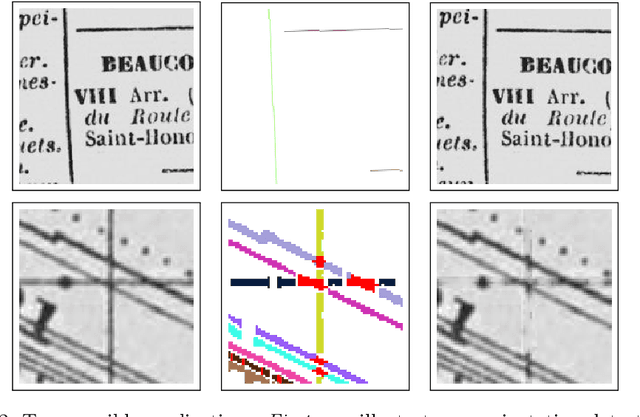
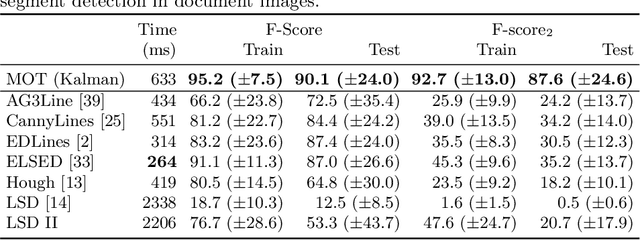
Abstract:Linear objects convey substantial information about document structure, but are challenging to detect accurately because of degradation (curved, erased) or decoration (doubled, dashed). Many approaches can recover some vector representation, but only one closed-source technique introduced in 1994, based on Kalman filters (a particular case of Multiple Object Tracking algorithm), can perform a pixel-accurate instance segmentation of linear objects and enable to selectively remove them from the original image. We aim at re-popularizing this approach and propose: 1. a framework for accurate instance segmentation of linear objects in document images using Multiple Object Tracking (MOT); 2. document image datasets and metrics which enable both vector- and pixel-based evaluation of linear object detection; 3. performance measures of MOT approaches against modern segment detectors; 4. performance measures of various tracking strategies, exhibiting alternatives to the original Kalman filters approach; and 5. an open-source implementation of a detector which can discriminate instances of curved, erased, dashed, intersecting and/or overlapping linear objects.
Entry Separation using a Mixed Visual and Textual Language Model: Application to 19th century French Trade Directories
Feb 17, 2023Abstract:When extracting structured data from repetitively organized documents, such as dictionaries, directories, or even newspapers, a key challenge is to correctly segment what constitutes the basic text regions for the target database. Traditionally, such a problem was tackled as part of the layout analysis and was mostly based on visual clues for dividing (top-down) approaches. Some agglomerating (bottom-up) approaches started to consider textual information to link similar contents, but they required a proper over-segmentation of fine-grained units. In this work, we propose a new pragmatic approach whose efficiency is demonstrated on 19th century French Trade Directories. We propose to consider two sub-problems: coarse layout detection (text columns and reading order), which is assumed to be effective and not detailed here, and a fine-grained entry separation stage for which we propose to adapt a state-of-the-art Named Entity Recognition (NER) approach. By injecting special visual tokens, coding, for instance, indentation or breaks, into the token stream of the language model used for NER purpose, we can leverage both textual and visual knowledge simultaneously. Code, data, results and models are available at https://github.com/soduco/paper-entryseg-icdar23-code, https://huggingface.co/HueyNemud/ (icdar23-entrydetector* variants)
QU-BraTS: MICCAI BraTS 2020 Challenge on Quantifying Uncertainty in Brain Tumor Segmentation -- Analysis of Ranking Metrics and Benchmarking Results
Dec 19, 2021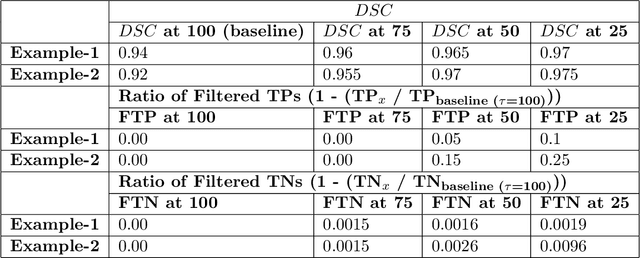
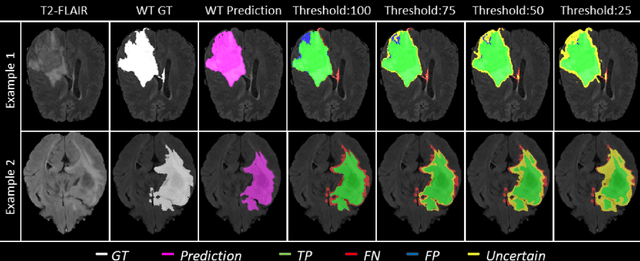

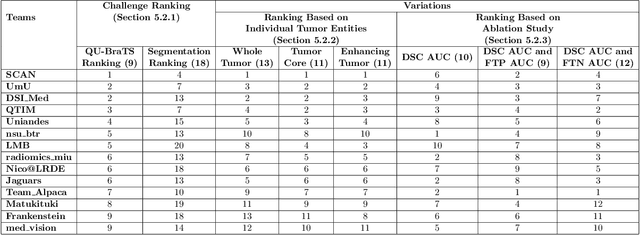
Abstract:Deep learning (DL) models have provided the state-of-the-art performance in a wide variety of medical imaging benchmarking challenges, including the Brain Tumor Segmentation (BraTS) challenges. However, the task of focal pathology multi-compartment segmentation (e.g., tumor and lesion sub-regions) is particularly challenging, and potential errors hinder the translation of DL models into clinical workflows. Quantifying the reliability of DL model predictions in the form of uncertainties, could enable clinical review of the most uncertain regions, thereby building trust and paving the way towards clinical translation. Recently, a number of uncertainty estimation methods have been introduced for DL medical image segmentation tasks. Developing metrics to evaluate and compare the performance of uncertainty measures will assist the end-user in making more informed decisions. In this study, we explore and evaluate a metric developed during the BraTS 2019-2020 task on uncertainty quantification (QU-BraTS), and designed to assess and rank uncertainty estimates for brain tumor multi-compartment segmentation. This metric (1) rewards uncertainty estimates that produce high confidence in correct assertions, and those that assign low confidence levels at incorrect assertions, and (2) penalizes uncertainty measures that lead to a higher percentages of under-confident correct assertions. We further benchmark the segmentation uncertainties generated by 14 independent participating teams of QU-BraTS 2020, all of which also participated in the main BraTS segmentation task. Overall, our findings confirm the importance and complementary value that uncertainty estimates provide to segmentation algorithms, and hence highlight the need for uncertainty quantification in medical image analyses. Our evaluation code is made publicly available at https://github.com/RagMeh11/QU-BraTS.
ICDAR 2021 Competition on Historical Map Segmentation
May 27, 2021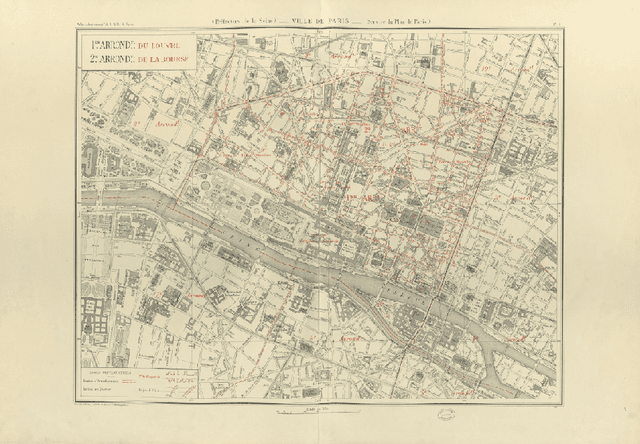



Abstract:This paper presents the final results of the ICDAR 2021 Competition on Historical Map Segmentation (MapSeg), encouraging research on a series of historical atlases of Paris, France, drawn at 1/5000 scale between 1894 and 1937. The competition featured three tasks, awarded separately. Task~1 consists in detecting building blocks and was won by the L3IRIS team using a DenseNet-121 network trained in a weakly supervised fashion. This task is evaluated on 3 large images containing hundreds of shapes to detect. Task~2 consists in segmenting map content from the larger map sheet, and was won by the UWB team using a U-Net-like FCN combined with a binarization method to increase detection edge accuracy. Task~3 consists in locating intersection points of geo-referencing lines, and was also won by the UWB team who used a dedicated pipeline combining binarization, line detection with Hough transform, candidate filtering, and template matching for intersection refinement. Tasks~2 and~3 are evaluated on 95 map sheets with complex content. Dataset, evaluation tools and results are available under permissive licensing at \url{https://icdar21-mapseg.github.io/}.
Combining Deep Learning and Mathematical Morphology for Historical Map Segmentation
Jan 06, 2021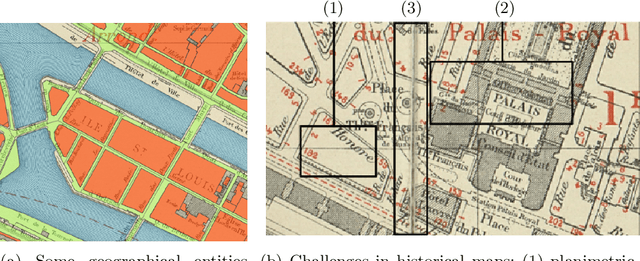


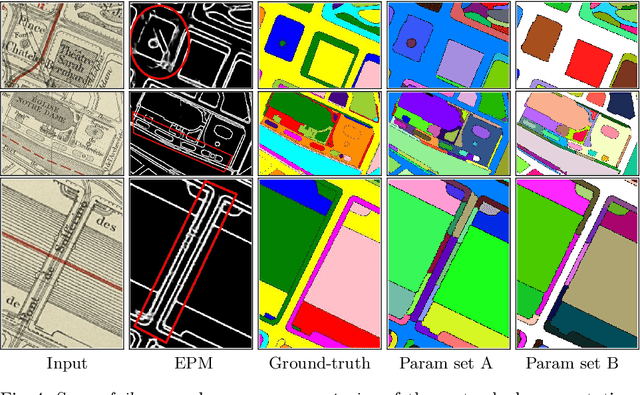
Abstract:The digitization of historical maps enables the study of ancient, fragile, unique, and hardly accessible information sources. Main map features can be retrieved and tracked through the time for subsequent thematic analysis. The goal of this work is the vectorization step, i.e., the extraction of vector shapes of the objects of interest from raster images of maps. We are particularly interested in closed shape detection such as buildings, building blocks, gardens, rivers, etc. in order to monitor their temporal evolution. Historical map images present significant pattern recognition challenges. The extraction of closed shapes by using traditional Mathematical Morphology (MM) is highly challenging due to the overlapping of multiple map features and texts. Moreover, state-of-the-art Convolutional Neural Networks (CNN) are perfectly designed for content image filtering but provide no guarantee about closed shape detection. Also, the lack of textural and color information of historical maps makes it hard for CNN to detect shapes that are represented by only their boundaries. Our contribution is a pipeline that combines the strengths of CNN (efficient edge detection and filtering) and MM (guaranteed extraction of closed shapes) in order to achieve such a task. The evaluation of our approach on a public dataset shows its effectiveness for extracting the closed boundaries of objects in historical maps.
 Add to Chrome
Add to Chrome Add to Firefox
Add to Firefox Add to Edge
Add to Edge